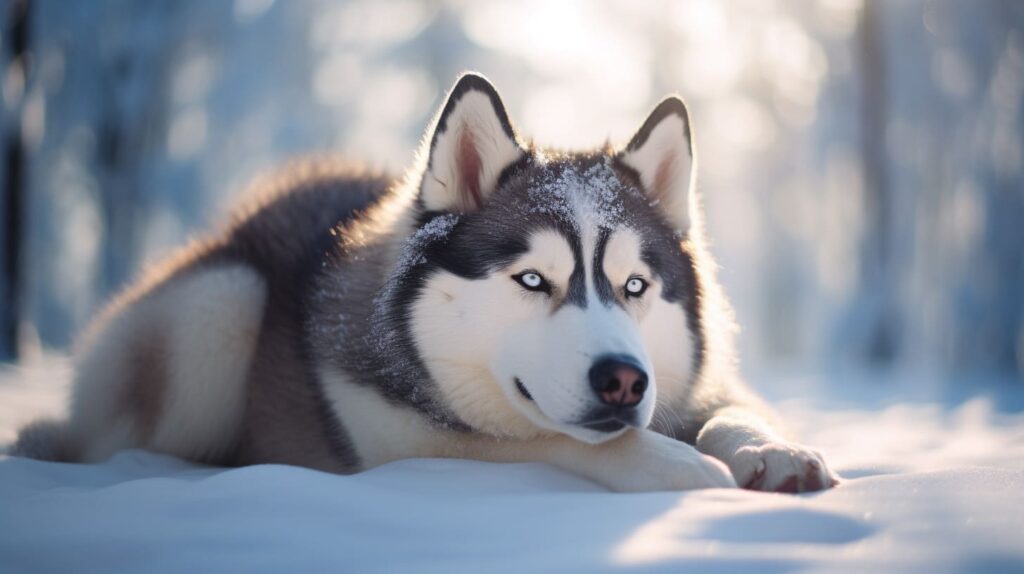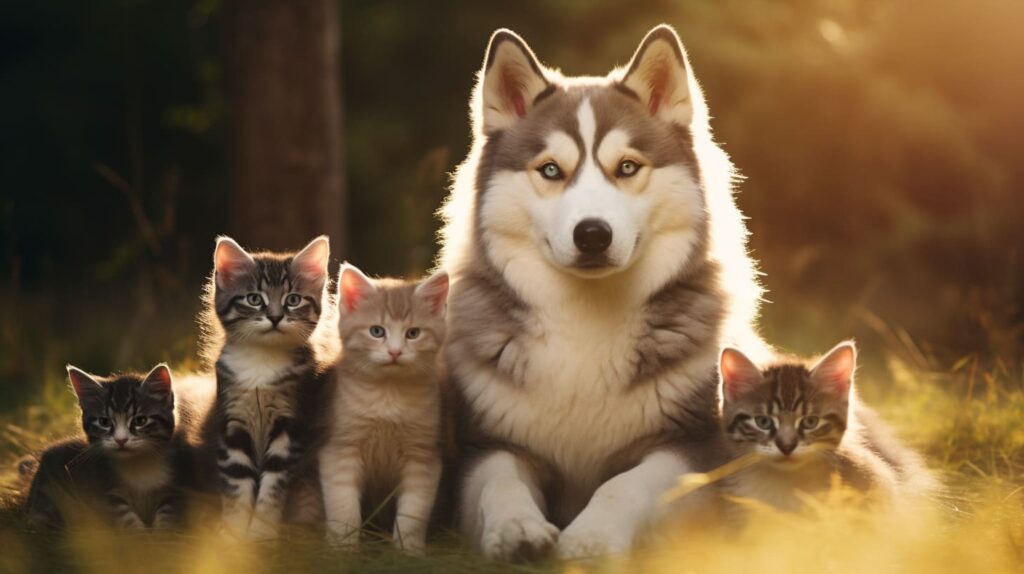Huskies are known for their vivacious spirit, boundless energy, and playful demeanor. They are a joy to be around, but their high energy levels can sometimes become overwhelming, especially in calm or serious settings. Training a Husky to be calm is not about curbing their natural enthusiasm but channeling it appropriately. It’s about teaching them when it’s time to play and when it’s time to settle down. This article will explore various techniques and strategies of how to train a husky to be calm and to help instill a sense of calmness in your Husky, ensuring a balanced and well-behaved companion. So, let’s embark on this tranquil training journey together!
Understanding Husky Behavior
Huskies are a breed with a rich history that dates back to Siberia’s cold, harsh climates. The Chukchi people of Siberia bred them for quickly pulling heavy sleds over long distances, thanks to their strength, endurance, and speed. Their job required them to be energetic, alert, and friendly. Understanding these intrinsic behaviors is the first step towards training a Husky to be calm.
Being intelligent dogs, Huskies are quick learners, but they also have a mind that can sometimes translate to a stubborn streak. Early socialization and exposure to various environments, noises, people, and other animals is crucial to molding a well-adjusted Husky. This early exposure helps them become more adaptable and less reactive to new experiences as they grow.
Besides their physical attributes, Huskies are known for their friendly and gentle temperament. They are not aggressive and tend to get along well with humans and other dogs. However, their friendly demeanor doesn’t mean they will always be calm. Huskies are known to get excited easily, especially when meeting new people or dogs, and during playtime.
Understanding the lineage and natural tendencies of Huskies provides a solid foundation for training them to be calm. By acknowledging their innate traits and working with them, rather than against them, you set the stage for a successful training experience. Tailoring your training methods to suit their personality and physical needs will yield better results and a calmer Husky.

Exercise and Mental Stimulation
A well-exercised Husky is a calmer Husky. Due to their high energy levels and intelligence, Huskies require good physical exercise and mental stimulation to keep them balanced. Without adequate outlets for their energy, they can become restless anxious, and display undesirable behaviors such as excessive barking, chewing, or digging.
Physical exercise is paramount. A daily walk, run, or hike routine will do wonders for burning off their pent-up energy. Huskies thrive in outdoor settings where they can explore and stretch their legs. Engage them in activities that mimic their natural behaviors, such as pulling or sledding. Play sessions in a secure, fenced area where they can run and play freely are also beneficial.
Mental stimulation is equally important to keep their sharp minds engaged. Huskies are intelligent and thrive on challenges. Provide them with puzzle toys, engage in training sessions, and play games that challenge their minds, such as hide and seek or fetch. Training sessions, in particular, are a great way to work their brains and can be used to reinforce calm behavior.
Incorporating obedience training during their exercise routine can also promote calmness. For instance, asking them to sit or stay intermittently during their walk or play can teach them self-control and calm behavior even when they are excited.
Structured playdates with other well-behaved dogs can also provide both physical and mental stimulation. It allows them to socialize, play, and learn from other dogs in a controlled environment.
An adequately exercised and mentally stimulated Husky is more likely to be calm and relaxed. It’s about finding the right balance of physical and mental activities that suit your Husky’s personality and energy levels. Tailoring their exercise and mental stimulation routine to meet their unique needs will contribute significantly towards training them to be calm. Remember, a tired Husky is a good, calm Husky!
Basic Obedience Training
Training a Husky to be calm begins with mastering the basics of obedience training. This foundation is crucial as it establishes your authority and creates a structured environment for your Husky. The primary commands like ‘sit’, ‘stay’, and ‘down’ are invaluable tools in promoting calm behavior.

Consistency is Key
Consistency in commands, gestures, and rules is essential. Huskies are smart and will quickly pick up on inconsistencies, which can lead to confusion and non-compliance. Ensure everyone in the household is on the same page regarding commands and rules.
Short and Engaging Sessions
Keep training sessions short, fun, and engaging to hold your Husky’s attention. Aim for about 5 to 10 minutes for puppy Huskies and up to 15 minutes for adults, several times a day. Use a cheerful, upbeat voice and lots of praises to make the training enjoyable.
Positive Reinforcement
Utilizing positive reinforcement techniques such as praises, treats, and petting will encourage your Husky to comply with the commands. Reward calm behavior promptly with treats and praises to reinforce the desired behavior.
Gradual Progression
Start with basic commands in a quiet, distraction-free environment. As your Husky masters these commands, gradually introduce distractions like other people or dogs, and practice in various settings.
The ‘Sit’ and ‘Stay’ Commands
The ‘sit’ and ‘stay’ commands are particularly useful in promoting calmness. Whenever your Husky gets excited or starts to display hyperactive behavior, use the ‘sit’ and ‘stay’ commands to redirect their energy and encourage calmness.
Practice Patience
Huskies might not get it right on the first try, and that’s okay. Practice patience and keep the training positive and stress-free. Over time, your Husky will learn to associate calm behavior with positive rewards, making them more likely to remain calm even in exciting or new situations.
Basic obedience training sets the groundwork for a well-behaved, calm Husky. It provides the necessary tools and techniques to manage and redirect your Husky’s energy effectively. With patience, consistency, and positive reinforcement, you will notice a significant improvement in your Husky’s behavior over time.
Calmness Training Techniques
Training a Husky to be calm may require some specialized techniques apart from basic obedience training. Here are some calmness training methods tailored for Huskies.

The “Settle” or “Relax” Commands
Teaching your Husky a command like “settle” or “relax” can be very useful. Start by saying the command when your Husky is naturally calm and relaxed, rewarding them with a treat and praise. Over time, they will associate the command with the behavior.
Capturing Calmness
This technique involves rewarding your Husky whenever they exhibit calm behavior spontaneously. Have some treats handy, and whenever you notice your Husky lying down quietly or being calm, reward them with a treat and gentle praise.
Mat Training
Mat training is about teaching your Husky to go to their mat and settle down. Start by leading your Husky to the mat with a treat, then reward them when they lie down on it. Over time, introduce the command “go to your mat” or “place,” rewarding them when they comply. This can be a great tool to encourage calmness, especially during meal times or when guests are over.
Mindfulness and Calmness Exercises
Engage in exercises that promote mindfulness and calmness. For instance, practicing long down-stays while you’re watching TV or working can encourage calmness and patience in your Husky.
Avoiding Over-excitement
Avoid situations that over-excite your Husky until they learn to control their excitement better. Gradually expose them to exciting situations, rewarding calm behavior, and removing them if they get too excited, working on it gradually over time.
Calming Signals
Learn to recognize and respond to your Husky’s calming signals like yawning, stretching, or slow blinking. Responding to these signals by rewarding or engaging in calming activities can encourage more calm behavior.
Calming Products
Consider using calming products like anxiety wraps or calming sprays, which can have a soothing effect on your Husky. However, it’s advisable to consult with your vet before using any products.
Each Husky is unique, and what works for one Husky may not work for another. It may take some time, patience, and a bit of trial and error to find what works best for your Husky. The key is to remain patient, consistent, and positive throughout the training process. Over time, with the right training techniques, you will notice your Husky becoming calmer and more manageable, even in situations that used to excite them.
Positive Reinforcement
The cornerstone of successful training, especially when it comes to instilling calmness in a Husky, is positive reinforcement. This method emphasizes rewarding good behavior rather than punishing undesirable actions.
Reward Calm Behavior
Rewarding your Husky with treats, praise, or petting whenever they exhibit calm behavior reinforces the notion that being calm leads to positive outcomes. It’s crucial to reward them immediately so they can make the connection between the behavior and the reward.
Use Calming Treats Wisely
There are treats available in the market formulated to promote calmness in dogs. These can be used as a part of your training regimen. However, ensure they are used in moderation and consult with your vet before introducing any new treats to your Husky’s diet.
Utilize Clicker Training
A clicker can be an excellent tool for positive reinforcement training. The click sound acts as a marker that a reward is coming, helping your Husky understand exactly what behavior is being rewarded. Click the moment your Husky exhibits calm behavior, followed by a treat or praise.
Avoid Negative Reinforcement
Negative reinforcement can lead to fear, anxiety, and may even exacerbate hyperactivity. It’s essential to maintain a positive, encouraging atmosphere during training sessions.
Establish a Calm Environment
Create a calm training environment by minimizing distractions and maintaining a calm demeanor yourself. Your Husky can pick up on your energy, so it’s beneficial to remain calm and patient during training sessions.
Use of Calming Aids
In conjunction with positive reinforcement, calming aids such as calming collars or diffusers can also be explored to promote a serene environment. These aids release pheromones that can help soothe anxious or hyperactive dogs.
Gradual Desensitization
If your Husky gets overly excited in specific situations, gradual desensitization can be helpful. Expose them to the exciting situation in a controlled, calm manner, rewarding them for calm behavior, and gradually increasing the exposure as they learn to remain calm.
Employing positive reinforcement methods to reward calm behavior will foster a positive association with being calm. Over time, with consistent training and a lot of patience, your Husky will learn to embrace a calmer demeanor, making your companionship even more enjoyable and harmonious.
Managing and Redirecting Excitability
Handling a Husky’s excitability requires a blend of management and redirection techniques. Here’s how to navigate through their ebullient spirits:
Redirecting Energy
When your Husky gets overexcited, redirect their energy towards something constructive. For instance, if they jump around when someone comes to the door, redirect them to a specific spot where they can sit and wait calmly for a reward.
Time-Outs
Utilizing time-outs can be effective in curbing over excitability. If your Husky becomes too hyper, calmly place them in a designated time-out area to calm down before resuming interaction.
Ignoring Hyper Behavior
Ignoring your Husky when they are hyper can send a strong message. Turn your back, avoid eye contact, and don’t engage until they calm down. Once they are calm, reward them with attention and treats.
Employing Calmness Techniques
Continue to employ calmness training techniques like the “settle” command or mat training to manage excitability. Over time, these techniques will help teach your Husky to calm down quicker.
Utilizing Toys and Puzzles
Engage your Husky with toys and puzzles that challenge their minds and redirect their energy when they get overly excited. Puzzle toys can also work to slow down their eating if mealtime gets them overly excited.
Calm Greeting Routines
Establish calm greeting routines to manage excitement when meeting new people or animals. Have your Husky sit and stay while being greeted, rewarding them for calm behavior.
Adequate Exercise
Ensure your Husky is receiving enough physical and mental exercise to burn off excess energy that could lead to over excitability.
Practicing Calm Behaviors
Practice calm behaviors in varying levels of exciting scenarios. Start in low distraction environments and gradually increase the level of distraction as your Husky becomes proficient at maintaining calmness.
Managing and redirecting excitability is about teaching your Husky to respond to exciting situations with calmness. It requires a lot of patience, consistency, and understanding of your Husky’s temperament and triggers. With time, practice, and positive reinforcement, you’ll be able to nurture a calmer demeanor in your Husky, enhancing the joy of your companionship.
Tips for how to calm a husky down
- Provide regular exercise: Huskies are an active breed and need plenty of physical activity to burn off excess energy. Plan daily walks or runs to help tire them out and promote relaxation.
- Engage in mental stimulation: Huskies are intelligent dogs and need mental challenges to stay calm. Use puzzle toys, obedience training, or interactive games to keep their minds occupied and prevent boredom.
- Create a calm environment: Huskies are sensitive to their surroundings, so it’s important to create a peaceful atmosphere for them. Reduce noise, keep their living space clean and organized, and provide a cozy and comfortable resting area.
- Establish a routine: Huskies thrive on routine and predictability. Set consistent meal times, exercise schedules, and bedtime routines to help them feel secure and calm.
- Use positive reinforcement: Reward calm behavior with treats, praise, and affection. This will reinforce the idea that being calm is a desirable behavior and encourage them to remain calm more often.
- Practice relaxation techniques: Teach your husky relaxation techniques such as deep breathing exercises or using a calming mat. These techniques can help them self-soothe and relax when they feel anxious or hyperactive.
- Use calming aids: Consider using natural calming aids such as lavender essential oil or calming pheromone diffusers. These can help create a soothing environment and promote relaxation for your husky.
- Avoid overstimulation: Huskies can become overstimulated easily, which can lead to hyperactivity. Limit exposure to high-energy situations, loud noises, or excessive playtime to prevent them from getting overly excited.
- Spend quality time together: Huskies are social dogs and enjoy spending time with their owners. Set aside dedicated time each day for bonding activities such as grooming, training, or cuddling. This can help them feel more secure and reduce anxiety.
- Consult a professional: If your husky’s hyperactivity persists despite your efforts, consider seeking advice from a professional dog trainer or veterinarian. They can provide tailored recommendations to help calm your husky down.
Seeking Professional Help if Necessary
Despite best efforts, there might be instances where seeking professional help is the prudent choice. This is particularly true if your Husky’s excitability is causing safety concerns or if you’re feeling overwhelmed.
Identifying the Need
If your Husky’s hyperactivity is leading to destructive behavior, aggression, or if they are unable to calm down even with consistent training, it might be time to consult a professional dog trainer or a veterinary behaviorist.
Professional Training Classes
Enrolling your Husky in professional training classes can provide structured learning environments that promote calmness and good behavior. It also provides an opportunity for socialization with other dogs under professional supervision.
Individual Behavior Consultation
A one-on-one consultation with a professional dog trainer or veterinary behaviorist can provide personalized training plans tailored to your Husky’s specific needs and challenges. They can identify triggers of hyperactivity and suggest effective management strategies.
Utilizing Calming Supplements or Medications
In some cases, calming supplements or medications might be recommended to manage extreme hyperactivity or anxiety. Always consult with your veterinarian before administering any new substances to your Husky.
Maintaining Open Communication
Maintain open communication with your veterinarian and any professional trainers you engage with. Ensure they are aware of all the behaviors you are concerned about and any changes you observe during the training process.
Exploring Alternative Therapies
Alternative therapies such as acupuncture, massage, or herbal remedies might be suggested by professionals to promote calmness and reduce anxiety in your Husky. It’s essential to have a discussion with your vet before exploring these options.
Continuous Learning
Engage in continuous learning by attending workshops, reading books, or joining local dog training groups to gain more knowledge and insights into managing your Husky’s behavior.
Seeking professional help is not a sign of failure but a responsible step towards ensuring the well-being and happiness of your Husky. It provides an avenue for more specialized assistance, ensuring a well-rounded, calm, and well-behaved companion. Remember, the journey to nurturing a calm Husky is a team effort that might sometimes require professional intervention for the best outcomes.
Patient and Consistent Training
Training a Husky to be calm is a journey that requires an abundance of patience and consistency. These two virtues are your allies in nurturing a well-behaved, tranquil companion.
Set Realistic Expectations
Understanding that training takes time and setting realistic expectations is crucial. Every Husky is unique, and progress may vary from one dog to another. Celebrate the small victories along the way as they signify progress.
Consistent Training
Consistency in commands, rules, and training sessions is vital. It helps your Husky understand what is expected of them, which in turn fosters a sense of security and calmness. Ensure everyone in the household adheres to the same rules and commands to avoid confusing your Husky.
Daily Training Sessions
Incorporate training sessions into your daily routine. Consistent daily training reinforces the learned behaviors and promotes long-term retention.
Stay Calm and Positive
Your demeanor during training sessions significantly impacts your Husky. Stay calm, patient, and maintain a positive, encouraging tone. Remember, your Husky is sensitive to your emotions and will respond better in a positive, stress-free environment.
Seek Support
Join local or online Husky or dog training communities for support, advice, and encouragement. Sharing experiences and learning from others can provide valuable insights and morale boosts during challenging times.
Monitor Progress
Keep a training log to monitor your Husky’s progress. Note down the successes, challenges, and any triggers of hyperactivity. This log can provide valuable insights and help tailor your training approach.
Adjust Training Techniques as Needed
Every Husky responds differently to training techniques. If a particular method isn’t yielding results, don’t hesitate to adjust your approach or seek professional advice.
Enjoy the Journey
Lastly, enjoy the training journey with your Husky. Cherish the bonding moments, the successes, and even the challenges. With every training session, you’re not only working towards a calmer Husky but also forging a stronger bond with your furry companion.
The road to a calm Husky is paved with patience, consistency, and a positive approach. By investing time, effort, and love in training your Husky, you’re setting the stage for a harmonious, joyful companionship that will last a lifetime.
Final Furry Thoughts
As we traverse through the exuberant world of Huskies, it becomes clear that training them to embrace a calm demeanor is not a mission impossible. With a blend of understanding their inherent behaviors, providing ample exercise and mental stimulation, instilling basic obedience, and employing specialized calmness training techniques, you can guide your Husky towards a serene path. The essence of positive reinforcement, coupled with the management and redirection of their boundless energy, forms the crux of nurturing a calm Husky.
Should challenges arise that seem insurmountable, remember that professional help is a resource at your disposal. Trainers and veterinary behaviorists can provide tailored strategies to usher calmness into your Husky’s life. The voyage of training may test your patience and consistency, but the rewards of sharing a tranquil bond with your Husky are unparalleled.
The tableau of training a Husky to be calm is a nuanced yet fulfilling endeavor, leading to a harmonious companionship. Your Husky is not just a pet, but a companion, a family member, and a friend. The investment of time, effort, and love in training them to be calm will enrich your relationship, making every moment spent together even more enjoyable and memorable. So, as you step onto the path of calmness training, remember to cherish every step, every challenge, and every success. Your Husky will thank you with a lifetime of love, loyalty, and serene companionship.






